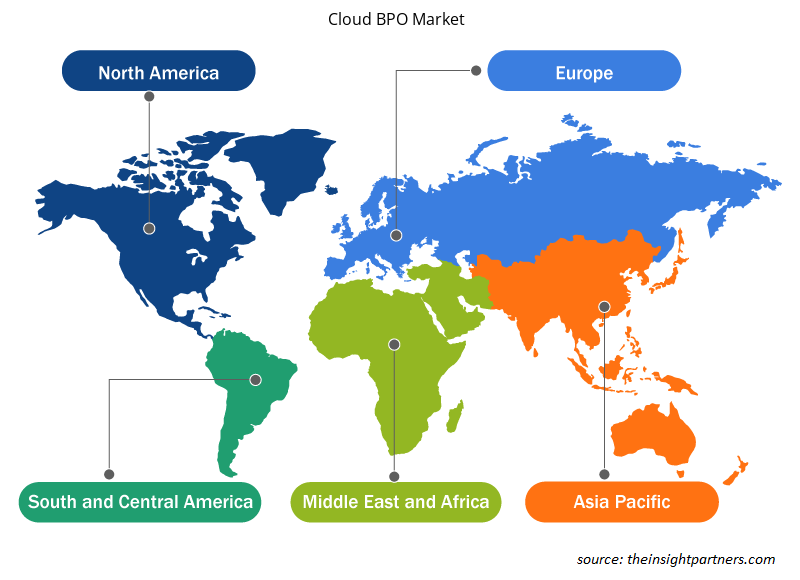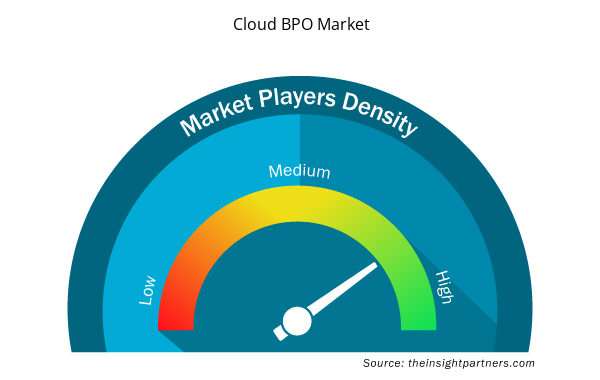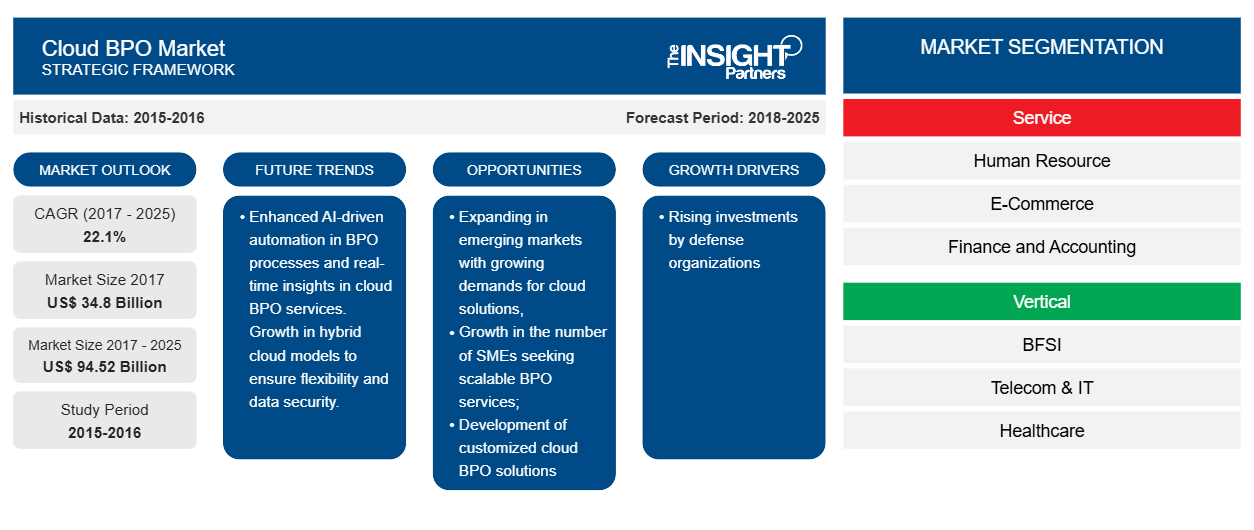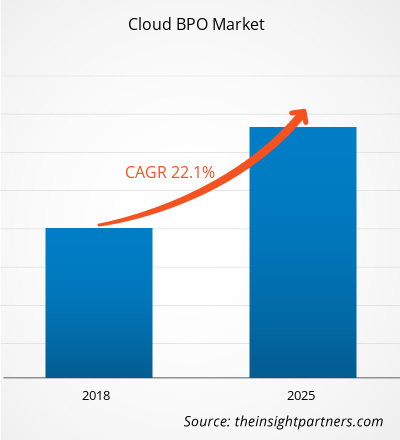Le marché du BPO cloud devrait passer de 34 801,2 millions USD en 2017 à 94 522,7 millions USD d'ici 2025 ; il devrait croître à un TCAC de 22,1 % de 2017 à 2025.
La réduction des coûts opérationnels et l'agilité offertes par le Cloud BPO contribuent à la croissance du marché. L'avantage de coût offert par le Cloud BPO est l'une des principales raisons qui influencent le choix des organisations en ce qui concerne les services BPO traditionnels. Il réduit considérablement le coût informatique de l'organisation en fournissant un support et une maintenance des logiciels et du matériel, et permet également de mettre à niveau, de mettre à jour et de gérer les processus sans effort, ce qui entraîne par la suite une réduction du coût des services commerciaux.
D’un autre côté, un BPO lui-même bénéficie grandement de l’intégration du cloud computing. Les fournisseurs de services BPO sont capables de tirer parti des avantages du cloud computing en réduisant le temps de traitement des processus commerciaux gourmands en données des organisations et en offrant un flux de travail de traitement des données dans un délai d’exécution compact. Les BPO Cloud bénéficient également de beaucoup de flexibilité en ajoutant facilement de nouvelles fonctions et fonctionnalités à leurs systèmes et en répondant efficacement aux demandes changeantes des clients. Les plateformes cloud offrent aux BPO une alternative agile et élastique en éliminant la pression de la concurrence à venir sur le marché. En raison de ces avantages offerts par le Cloud BPO, les entreprises de tous les secteurs préfèrent externaliser leurs processus commerciaux à des fournisseurs de services Cloud BPO, alimentant ainsi la croissance du marché Cloud BPO à l’échelle mondiale.
Personnalisez ce rapport en fonction de vos besoins
Vous bénéficierez d'une personnalisation gratuite de n'importe quel rapport, y compris de certaines parties de ce rapport, d'une analyse au niveau des pays, d'un pack de données Excel, ainsi que de superbes offres et réductions pour les start-ups et les universités.
- Obtenez les principales tendances clés du marché de ce rapport.Cet échantillon GRATUIT comprendra une analyse de données, allant des tendances du marché aux estimations et prévisions.
Informations sur le marché–
Marché du BPO dans le Cloud
Obligation d'améliorer le service client
Dans l'environnement hautement concurrentiel d'aujourd'hui, les clients sont bien conscients de leur puissance et de leur valeur croissantes, car ils ont découvert l'économie numérique et ont obtenu l'accès à divers services dans le monde entier. Cela a encore accru leurs attentes en matière de services basés sur le cloud, car les organisations sont devenues plus conscientes des avantages des services BPO Cloud. Le cloud en tant que plate-forme de base a déjà été exploité par les clients comme une nouvelle initiative externe et interne, ce qui a par la suite accru la concurrence entre les fournisseurs de services BPO, les motivant davantage à adopter des technologies improvisées telles que les technologies basées sur le cloud pour mieux servir leurs clients.BPO services. The cloud as a core platform has been already been leveraged by the clients as a novel external as well as internal initiative, which has subsequently increased the competition among the BPO service providers, further motivating them to adopt improvised technologies such as cloud based technologies to serve their customers/clients in a better way.
Informations basées sur les services
En fonction des services, le marché du BPO cloud est segmenté en ressources humaines, commerce électronique, finances et comptabilité, service client, ventes et marketing, etc. Le segment des ressources humaines détenait la plus grande part de marché en 2016.
Les acteurs opérant sur le marché du BPO cloud se concentrent principalement sur le développement de produits avancés et efficaces.
- En 2017, IBM et Dream Payments étendent leurs services de paiement sur le cloud aux institutions financières américaines.
- En 2017, le Groupe CMA CGM signe un partenariat stratégique avec Infosys pour accélérer la transformation de ses systèmes d’information.
Aperçu régional du marché du BPO dans le cloud
Les tendances et facteurs régionaux influençant le marché du Cloud BPO tout au long de la période de prévision ont été expliqués en détail par les analystes d’Insight Partners. Cette section aborde également les segments et la géographie du marché du Cloud BPO en Amérique du Nord, en Europe, en Asie-Pacifique, au Moyen-Orient et en Afrique, ainsi qu’en Amérique du Sud et en Amérique centrale.

- Obtenez les données régionales spécifiques au marché du Cloud BPO
Portée du rapport sur le marché du BPO dans le cloud
| Attribut de rapport | Détails |
|---|---|
| Taille du marché en 2017 | 34,8 milliards de dollars américains |
| Taille du marché d'ici 2025 | 94,52 milliards de dollars américains |
| Taux de croissance annuel composé mondial (2017-2025) | 22,1% |
| Données historiques | 2015-2016 |
| Période de prévision | 2018-2025 |
| Segments couverts | Par service
|
| Régions et pays couverts | Amérique du Nord
|
| Leaders du marché et profils d'entreprises clés |
|
Densité des acteurs du marché : comprendre son impact sur la dynamique des entreprises
Le marché du Cloud BPO connaît une croissance rapide, tirée par la demande croissante des utilisateurs finaux en raison de facteurs tels que l'évolution des préférences des consommateurs, les avancées technologiques et une plus grande sensibilisation aux avantages du produit. À mesure que la demande augmente, les entreprises élargissent leurs offres, innovent pour répondre aux besoins des consommateurs et capitalisent sur les tendances émergentes, ce qui alimente davantage la croissance du marché.
La densité des acteurs du marché fait référence à la répartition des entreprises ou des sociétés opérant sur un marché ou un secteur particulier. Elle indique le nombre de concurrents (acteurs du marché) présents sur un marché donné par rapport à sa taille ou à sa valeur marchande totale.
Les principales entreprises opérant sur le marché du Cloud BPO sont :
- Solutions Firstsource Ltée.
- WNS (Holdings) Ltd.
- Infosys Ltd.
- HCL Technologies Ltée.
- Genpact Ltée.
Avis de non-responsabilité : les sociétés répertoriées ci-dessus ne sont pas classées dans un ordre particulier.

- Obtenez un aperçu des principaux acteurs du marché du Cloud BPO
Le marché du BPO cloud a été segmenté comme suit :
Marché du BPO dans le Cloud – par services
- Ressources humaines
- Commerce électronique
- Finances et Comptabilité
- Service à la clientèle
- Ventes et marketing
- Autres
Marché du BPO dans le Cloud – par secteur
- BFSI
- Télécoms et informatique
- Soins de santé
- Automobile
- Fabrication
- Alimentation et boissons
- Pouvoir et énergie
- Électronique grand public
- Autres
Marché du BPO dans le Cloud – par géographie
Amérique du Nord
- NOUS
- Canada
- Mexique
Europe
- France
- Allemagne
- Italie
- Espagne
- ROYAUME-UNI
Asie-Pacifique (APAC)
- Japon
- Chine
- Australie
- Inde
Moyen-Orient et Afrique (MEA)
- Arabie Saoudite
- Émirats arabes unis
- Afrique du Sud
Amérique du Sud (SAM)
- Brésil
Marché du BPO dans le Cloud – Profils d’entreprises
- Société IBM
- Société Oracle
- SAP SE
- HPE
- Conscient
- Infosys
- Accenture
- Conseil Tata
- Système financier Sungard
- Wipro
- Historical Analysis (2 Years), Base Year, Forecast (7 Years) with CAGR
- PEST and SWOT Analysis
- Market Size Value / Volume - Global, Regional, Country
- Industry and Competitive Landscape
- Excel Dataset

Report Coverage
Revenue forecast, Company Analysis, Industry landscape, Growth factors, and Trends

Segment Covered
This text is related
to segments covered.

Regional Scope
North America, Europe, Asia Pacific, Middle East & Africa, South & Central America

Country Scope
This text is related
to country scope.
Frequently Asked Questions
The Human Resource Outsourcing services offered by the Cloud BPOs facilitate the organizations approach the core HRO needs while synergizing business objectives with resource utilization.
Surging demand for Cloud BPO is aligned with the progression in global market for Robotic Process Automation (RPA). The RPA with other digital disruptors comprise of digital labor and advanced software automation has a potential to drive the new generation of Cloud BPOs facilities that offer virtual workforce.
North America region holds the largest market share in the cloud BPO market, owing to rising demand from the public sector, mid-size banking, healthcare sector and financial service organizations. The cloud based outsourcing industry in the region has recently witnessed multiple merger & acquisitions, partnerships and reconstruction which makes the market to grow efficiently in North America.
Trends and growth analysis reports related to Technology, Media and Telecommunications : READ MORE..
The List of companies
1. Firstsource Solutions Ltd.
2. WNS (Holdings) Ltd.
3. Infosys Ltd.
4. HCL Technologies Ltd.
5. Genpact Ltd.
6. Capgemini SE
7. CA Inc.
8. Atos SE
9. Tata Consultancy Services Ltd.
10. DXC Technology Company
11. Sungard
12. Accenture PLC
13. ADP LLC
14. IBM Corporation
15. Oracle Corporation
16. SAP SE
17. Xerox Corp.
18. HPE
The Insight Partners performs research in 4 major stages: Data Collection & Secondary Research, Primary Research, Data Analysis and Data Triangulation & Final Review.
- Data Collection and Secondary Research:
As a market research and consulting firm operating from a decade, we have published and advised several client across the globe. First step for any study will start with an assessment of currently available data and insights from existing reports. Further, historical and current market information is collected from Investor Presentations, Annual Reports, SEC Filings, etc., and other information related to company’s performance and market positioning are gathered from Paid Databases (Factiva, Hoovers, and Reuters) and various other publications available in public domain.
Several associations trade associates, technical forums, institutes, societies and organization are accessed to gain technical as well as market related insights through their publications such as research papers, blogs and press releases related to the studies are referred to get cues about the market. Further, white papers, journals, magazines, and other news articles published in last 3 years are scrutinized and analyzed to understand the current market trends.
- Primary Research:
The primarily interview analysis comprise of data obtained from industry participants interview and answers to survey questions gathered by in-house primary team.
For primary research, interviews are conducted with industry experts/CEOs/Marketing Managers/VPs/Subject Matter Experts from both demand and supply side to get a 360-degree view of the market. The primary team conducts several interviews based on the complexity of the markets to understand the various market trends and dynamics which makes research more credible and precise.
A typical research interview fulfils the following functions:
- Provides first-hand information on the market size, market trends, growth trends, competitive landscape, and outlook
- Validates and strengthens in-house secondary research findings
- Develops the analysis team’s expertise and market understanding
Primary research involves email interactions and telephone interviews for each market, category, segment, and sub-segment across geographies. The participants who typically take part in such a process include, but are not limited to:
- Industry participants: VPs, business development managers, market intelligence managers and national sales managers
- Outside experts: Valuation experts, research analysts and key opinion leaders specializing in the electronics and semiconductor industry.
Below is the breakup of our primary respondents by company, designation, and region:

Once we receive the confirmation from primary research sources or primary respondents, we finalize the base year market estimation and forecast the data as per the macroeconomic and microeconomic factors assessed during data collection.
- Data Analysis:
Once data is validated through both secondary as well as primary respondents, we finalize the market estimations by hypothesis formulation and factor analysis at regional and country level.
- Macro-Economic Factor Analysis:
We analyse macroeconomic indicators such the gross domestic product (GDP), increase in the demand for goods and services across industries, technological advancement, regional economic growth, governmental policies, the influence of COVID-19, PEST analysis, and other aspects. This analysis aids in setting benchmarks for various nations/regions and approximating market splits. Additionally, the general trend of the aforementioned components aid in determining the market's development possibilities.
- Country Level Data:
Various factors that are especially aligned to the country are taken into account to determine the market size for a certain area and country, including the presence of vendors, such as headquarters and offices, the country's GDP, demand patterns, and industry growth. To comprehend the market dynamics for the nation, a number of growth variables, inhibitors, application areas, and current market trends are researched. The aforementioned elements aid in determining the country's overall market's growth potential.
- Company Profile:
The “Table of Contents” is formulated by listing and analyzing more than 25 - 30 companies operating in the market ecosystem across geographies. However, we profile only 10 companies as a standard practice in our syndicate reports. These 10 companies comprise leading, emerging, and regional players. Nonetheless, our analysis is not restricted to the 10 listed companies, we also analyze other companies present in the market to develop a holistic view and understand the prevailing trends. The “Company Profiles” section in the report covers key facts, business description, products & services, financial information, SWOT analysis, and key developments. The financial information presented is extracted from the annual reports and official documents of the publicly listed companies. Upon collecting the information for the sections of respective companies, we verify them via various primary sources and then compile the data in respective company profiles. The company level information helps us in deriving the base number as well as in forecasting the market size.
- Developing Base Number:
Aggregation of sales statistics (2020-2022) and macro-economic factor, and other secondary and primary research insights are utilized to arrive at base number and related market shares for 2022. The data gaps are identified in this step and relevant market data is analyzed, collected from paid primary interviews or databases. On finalizing the base year market size, forecasts are developed on the basis of macro-economic, industry and market growth factors and company level analysis.
- Data Triangulation and Final Review:
The market findings and base year market size calculations are validated from supply as well as demand side. Demand side validations are based on macro-economic factor analysis and benchmarks for respective regions and countries. In case of supply side validations, revenues of major companies are estimated (in case not available) based on industry benchmark, approximate number of employees, product portfolio, and primary interviews revenues are gathered. Further revenue from target product/service segment is assessed to avoid overshooting of market statistics. In case of heavy deviations between supply and demand side values, all thes steps are repeated to achieve synchronization.
We follow an iterative model, wherein we share our research findings with Subject Matter Experts (SME’s) and Key Opinion Leaders (KOLs) until consensus view of the market is not formulated – this model negates any drastic deviation in the opinions of experts. Only validated and universally acceptable research findings are quoted in our reports.
We have important check points that we use to validate our research findings – which we call – data triangulation, where we validate the information, we generate from secondary sources with primary interviews and then we re-validate with our internal data bases and Subject matter experts. This comprehensive model enables us to deliver high quality, reliable data in shortest possible time.




 Get Free Sample For
Get Free Sample For